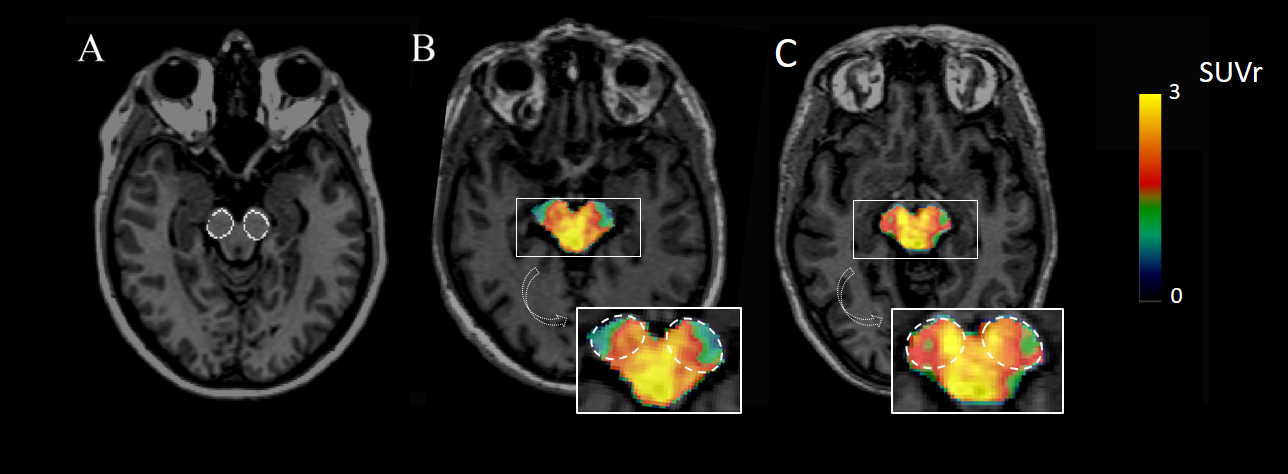In normal conditions, neuroinflammation is an immune mechanism to protect the brain from external aggressions and ensure homeostasis therein. Over the past few years however, researchers have suspected a role for it in certain neurodegenerative disease. Recent studies on postmortem brain tissue samples taken from patients with Parkinson's disease have pointed to neuroinflammation as a significant contributor to the neurodegenerative process, notably in the dopaminergic pathway* between the substantia nigra and the striatum. Nonetheless, several aspects remain unknown, for example the precise topography of neuroinflammation in patients or the relation between dopamine production reduction and neuroinflammatory response.
Inflammation in this setting is associated with neuroimmune cell (microglia and astrocytes) activation, which can be observed by positron emission tomography (PET). PET is a non-invasive functional imaging technique that employs radiotracers to visualize metabolic processes in tissues. The technique is particularly advantageous for observing and quantifying immune activation in the brain. Among the available radiotracers, [¹⁸F]-DPA714 holds particular promise for clinical use in this setting. It binds to an immune-cell mitochondrial translocator protein (TSPO) that is over-expressed in inflammation. That aspect in combination with several others makes it particularly pertinent as a specific radiotracer for neuroinflammation in brain PET imaging.
In a collaborative work involving the BioMaps unit of the Frédéric Joliot Medical Imaging Center (SHFJ; CEA-Joliot) and the Henri-Mondor and Saint-Anne Hospitals, researchers from MIRCen used PET imaging to analyze neuroinflammatory response in a cohort of 25 patients in different stages of Parkinson's disease. Their results, published in Parkinsonism & Related Disorders, pointed to a correlation between neuroinflammation and disease progression. The study employed two radiotracers in parallel: [¹⁸F]-DPA714 to compare the topography of microglia activation in healthy and sick subjects; and [¹¹C]-PE2I, which is specific to presynaptic dopamine transporters, to estimate dopaminergic neuron death in patients affected by the disease.
The researchers found significantly increased rates of [¹⁸F]-DPA714 fixation in specific regions of the patients' brains, i.e., the substantia nigra, the putamen and the frontal cortex. Interestingly, dopaminergic neurons, which degenerate in Parkinson's disease, originate within the substantia nigra; this structure is thus one of the first to be affected in disease course. The putamen is one of the main brain regions toward which the dopaminergic neurons in the substantia nigra project. Thus, it is no coincidence that neuroinflammation was detected in these regions and that it was more pronounced in patients with more severe clinical manifestations of disease. The results of the MIRCen team's study confirm those of other studies done using different TSPO tracers in smaller cohorts.
Additionally, the observed increase in neuroinflammation did not appear to follow the course of the degenerative process in those regions. Thus, neuroinflammation may be associated only with certain phases of disease, but that remains hypothetical until confirmed.
The researchers looked at [¹⁸F]-DPA714 binding in the whole cerebral cortex** as well, and found a significant correlation between it and disease severity, suggesting that neuroinflammation follows the pathological lesion process from the substantia nigra toward and through the cortex.

In its study, the multi-institution team was able to monitor the presence and distribution of neuroinflammation in patients with Parkinson's disease using the [¹⁸F]-DPA714 radiotracer. The ability to clearly visualize the increase in neuroinflammatory response in disease-affected cerebral regions opens doors to the use of the radiotracer to evaluate specific anti-inflammatories in patients suffering from this degenerative disorder.
* : Parkinson's disease is characterized mainly by the death of a certain type of nerve cells called dopaminergic neurons. These latter synthesize the neurotransmitter dopamine and originate mainly from a small brain region called the substantia nigra, ("black substance" in Latin as the structure appears darker than its surroundings because of a high level of neuromelanin).
** : The cerebral cortex (sometimes cerebral mantle) describes the peripheral layers of the brain's hemispheres.